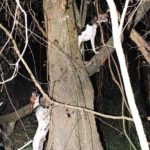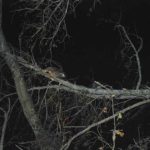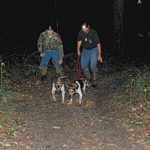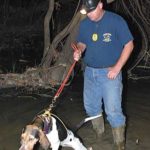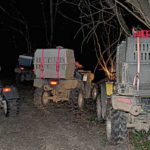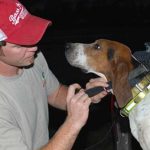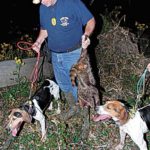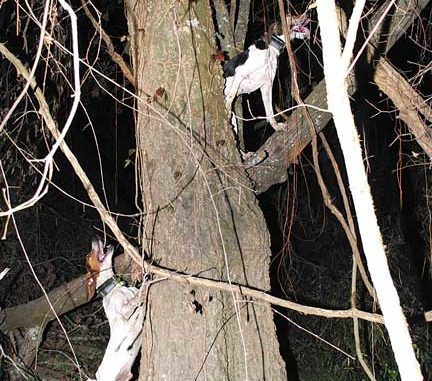
Hunting seasons are over, right? Actually, hunting never ends for this group of night owls.
Somewhere deep in the Mississippi River bottomlands between Devil’s Swamp and Port Hudson, I stood in complete darkness, mesmerized by the echoes of the basso profundo bugling of Rock and the contralto bawling of Memphis, two first-class walker coon hounds. The eerie music sent involuntary shivers of awe and delight down my spine.
When the dogs opened up, complete silence descended on the group of seven hunters, who were broken into three sets of men. A group of three who provided access to the area, Pat Fuller, Corky Landry and Bob Stott, all from the Baton Rouge area, had been quietly swapping deer and turkey stories.
Well advanced from the three were the dogs’ handlers, Whit Harvey and Brad Gottschalck, both of Central. In the faint starlight, I could see these two silent men were clearly in a zone, and seemed to be projecting their spirits through the dark woods to hover over their trailing hounds.
Near a cluster of parked ATVs stood two men from Pine, Roger Dale Carnegie and Zander Thomas.
Carnegie, who was clearly the papa bear of the group, leaned against an ATV in lordly silence, puffing on one of his ever-present cigarettes. Thomas, no mean dog handler himself, stood ready to spring to action when the dogs treed their quarry.
Earlier in the afternoon, as a prelude to the hunt, Harvey, Gottschalck, Carnegie and Thomas shared a country feast of white beans and rice, deer sausage and smothered cabbage, topped off with “marshmallow stew,” at Harvey’s father Ronnie’s home in Central. While the elder Harvey labored mightily in the kitchen, Harvey talked about coon hunting in general and the hunt tonight, while the verbally parsimonious Gottschalck mostly listened and nodded his head.
Tonight we would be hunting with two Walker hounds, Rock and Memphis, both of which are actively trained for and used in competitive coon hunting in Professional Kennel Club (PKC) competitions. The dogs and several others were owned by Carnegie prior to his purchase of PKC. Harvey and Gottschalck handled the dogs in competition for Carnegie, and now Harvey has ownership of the animals.
PKC hunts are highly organized and judged events. But tonight’s hunt would be what the men called “a pleasure hunt.” As the name implies, a pleasure hunt is made with the intention of having fun, but a serious side also exists. Without regular hunts of this type to keep the dogs in shape, they could never compete successfully, says Harvey.
Another difference between pleasure hunts and competitive hunts is that in competition the raccoon is never killed. Tonight, the landowner and the lease holder of the lands to be hunted have requested that any raccoons treed be taken by the hunters, as they consider them to be overpopulous pests that damage deer feeders and attack turkey nests.
Shooting a raccoon occasionally for the dogs to grab is also considered to be important for keeping the hounds’ tuned up for competition.
“Dogs need a little meat in their mouth to stay interested,” says Harvey.
He adds that he kills more raccoons when he is training a puppy than when he is working older, experienced dogs.
He estimates that he probably kills fewer than 10 raccoons a year now, although he says that some years ago, when raccoon hides were worth more money than they are now, he killed quite a few.
Harvey got his first coon dog at age 11, and has been hunting raccoons intensely for the 26 years since. A strapping big fellow, with a big dimple on his chin, he is so devoted to coon hunting that he says he hasn’t had time to consider getting married.
His schedule says it all. He coon hunts competitively from 75 to 100 nights per year. On top of that, he pleasure hunts for raccoons an incredible average of 18 nights per month, year-round.
“One of the great things about coon hunting is that it is a year-round sport,” he said. “You’ve really gotta love it to do it in July, August and September though,” he adds, shaking his head slowly. “But if you lay the dogs up all summer, they get out of shape and aren’t competitive.
As much time as he devotes to coon hunting, he still hunts deer, squirrels and turkeys in season, and he holds a full-time job. Time to get married? No way! And Gottschalck seems to be following in his footsteps.
At 7:30 p.m., three trucks towing trailers with five ATVs left the Sportsman’s 1 Stop, Fuller’s business on Highway 61 north of Baton Rouge. At Landry’s hunting camp, the men unloaded the ATVs, and put the hounds in two kennels carried on the rear of Harvey’s and Gottschalck’s vehicles. Before kenneling them, the two men strapped two tracking collars on each dog. One would be used to track the animal with telemetry equipment and the other with a GPS receiver.
“We don’t lose too many dogs,” Harvey said. “Dogs ain’t got no reverse. Where the coon goes, the dog goes, and where the dog goes, I go. When I used to hunt in Devil’s Swamp itself a lot, I swam sloughs at night many a time to get to my dogs. I don’t leave dogs in the woods.”
In a few minutes, the ATVs reached the spot on Stott’s family land where they wanted to cast the dogs loose. Harvey and Gottschalck led the dogs, straining on their leashes, 20 yards or so away from the other men. When their leashes were unsnapped, the creatures dove into the dark woods in two flashes of white. Each animal gave an anxious howl before disappearing.
Before he turned his headlight off, Harvey looked at me and prepared me for what was to come.
“Sometimes we will tree three times in an hour-and-a-half, and sometimes we cut them loose and never tree,” he said. “Then, we might not get our dogs back until daylight.”
But tonight we were lucky. Within 10 minutes, the dogs were on full trail and filling the woods with haunting yodels. Abruptly, the sound of the music changed, and the baying became frenzied.
“They’re treed,” said Harvey simply. “Let’s go.”
The caravan of five ATVs carrying the seven men snaked sinuously through the dark woods, avoiding the many downed trees and deadfalls produced by Hurricane Gustav. Skilful maneuvering brought the men’s ATVs to within 50 feet of the treed dogs.
Pure beautiful bedlam prevailed. The two dogs were going berserk in their excitement and desire to reach the raccoon. Memphis had climbed a deadfall to 8 feet off of the ground, and was looking for purchase to climb higher, but never stopping her frantic baying. Rock was even louder and more persistent, as if trying to make up for his lack of climbing ability by making more noise.
“Two big coons,” commented one of the hunters after shining the tree briefly with his headlight.
Harvey quickly coaxed Memphis down from her perch. Accounts of excited hounds falling to their deaths are common. Harvey, Gottschalck and Thomas got leashes on the animals, and pulled them away from the tree.
The lone piece of armament on the hunt, a .22 rifle, was produced, but the two raccoons became shy and hid themselves and their light-reflecting eyes.
The most gawd-awful noise rent the air. Thomas and Harvey were blowing raccoon calls called “squallers.” Gottschalck added to the discordant cacophony by doing the same thing by mouth.
Whether out of curiosity or because they believed that suicide was a better option than having to listen to the din, both animals showed themselves to the hunters, and were quickly dispatched. The two dogs were turned loose to worry the dead raccoons, or as Harvey put it, “to have a chew.”
Their fun didn’t last long. The dogs were leashed, and Harvey turned to Stott and said, “I’m ready to make another cast. Where to?”
Stott led them to another spot that he thought would be good.
The dogs were cast the same way, and again they took off into the woods in high gear. Again, the two dog handlers stood off from the other hunters, enraptured in the dogs’ music.
Harvey looked my way in the dark and explained that every dog has his own voice and that a handler can not only recognize that voice but understand what the dog is doing by its vocalizations.
He explained that hounds’ voices can be put into two categories.
“They either have a bawl mouth or a chop,” he said.
A bawl mouth is the long drawn-out classical whoooo-sound. A chop is more of a drawn-out bark.
“These two dogs,” he said, “have a bawl mouth when tracking and a chop when treed. But every dog is different.”
He no sooner finished his discourse on dogs’ voices when the two animals excitedly began to chop at a tree. Again, the caravan moved to the action, but this time the ATV-run was over more-difficult terrain. When the hunters reached the tree, the scene was similar to the last tree, but this time Memphis was a good 14 feet off the ground, up in a blown-down tree top.
The dogs were leashed and pulled from the tree while the raccoon was brought down with a couple of shots. Here again, the dogs were given a brief chew as their reward.
Within minutes, the men were back on the trail to make their third and final cast of the night near a cypress slough. The release of the dogs showed that they had lost none of their enthusiasm, their claws throwing clods of mud in the air as they accelerated into the woods.
The croaking of frogs broke the dead silence as we waited. Somewhere nearby, an owl hooted.
First Memphis cut a scent trail and keened. Then both dogs opened up, and within 10 minutes, their melodic bawls turned into the raucous bark that signaled a successful treeing. This time, the raccoon had ascended a much smaller tree before crossing over into a larger one. But both dogs were pinned to the small tree. Their actions were so frenzied that it seemed they might suffer a coronary.
After taking the raccoon, the hunters drove their ATVs back to Landry’s camp, and relived the hunt over refreshments before breaking up.
Coon hunting is a relatively new experience for Stott and Landry, but both men seemed to have enjoyed the experience. Harvey observed to the group that it had been his experience that people either love or hate coon hunting.
“There is no in-between,” he drawled.
During the truck ride back to Central, both Harvey and Gottschalck were quiet, as if lost in thought. After a half-hour, Harvey mused in a soft voice, “Coon hunters hunt because they love the music. The foremost thing is to love the hounds. Only secondly do most of us love the challenge of competition
hunting.”
